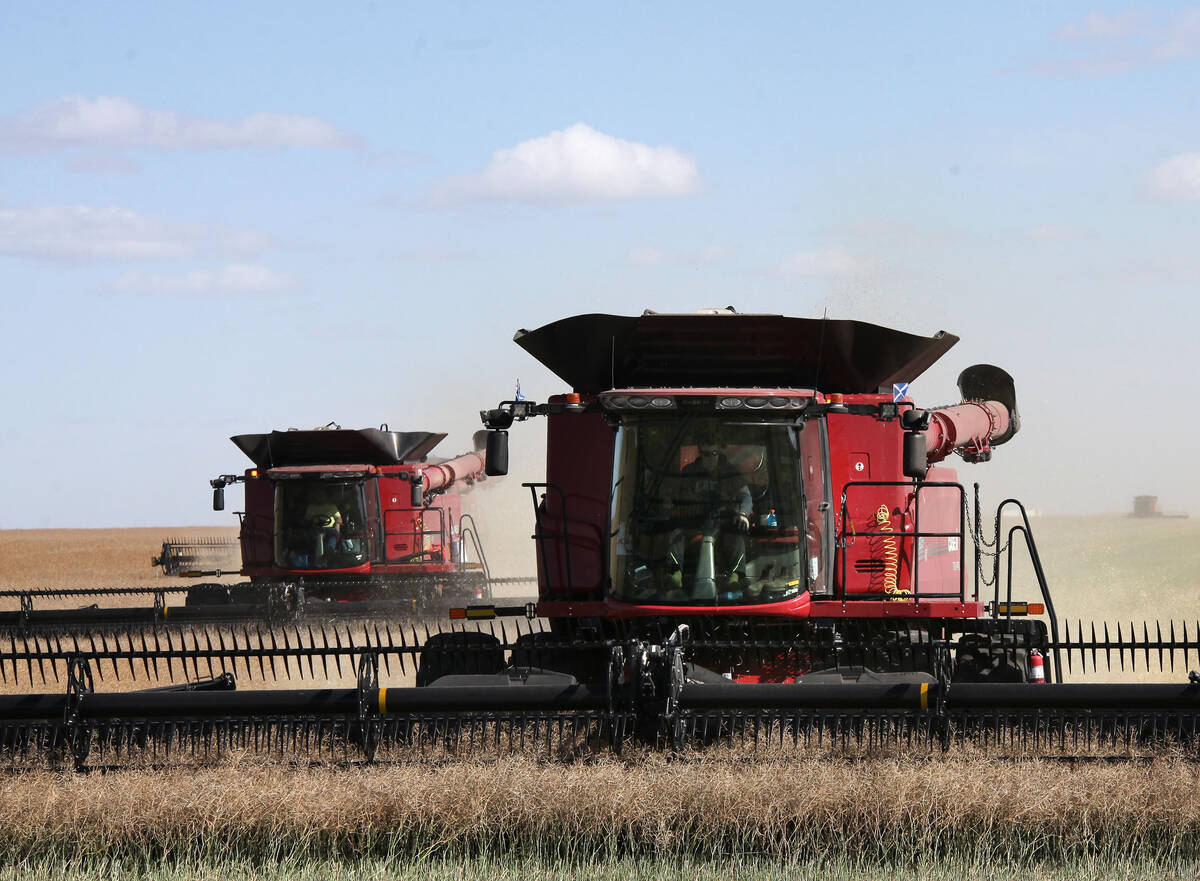Proposals to increase a crop chemical’s maximum residue limits (MRLs) on foods and food crops in Canada can again seek federal approval, after being put on temporary hold two years ago.
Among several other changes, a planned new package of federal regulatory amendments will put a gradual end to a “pause” imposed in August 2021 on such proposed MRL increases, which are overseen by Health Canada’s Pest Management Regulatory Agency (PMRA).
Federal Agriculture Minister Marie-Claude Bibeau, Health Minister Jean-Yves Duclos and Environment Minister Steven Guilbeault announced the planned amendments Tuesday, in what are billed as Canada’s “next steps toward a sustainable approach to pesticides management, while giving farmers the tools they need to keep providing reliable access to safe and nutritious food.”
Read Also

Notable changes in exports to China, India
China and India figured prominently in the September export data issued by the Canadian Grain Commission on Nov. 7. For the most part, the CGC’s numbers highlighted issues with grain, oilseed and pulse exports from licensed facilities to those countries.
The term “MRL” refers to the highest legally allowed amount of pesticide residue that may remain on or in food when a pesticide is used according to label directions. Different MRLs are set for different combinations of chemicals and foods, depending on how a pesticide is applied for a given crop.
Ottawa’s 2021 pause had been imposed in response to public concerns specifically regarding a boost to MRLs for glyphosate herbicide, as was proposed in May that year for certain imported commodities.
That proposal, Bibeau said Wednesday in an interview, was meant to have brought Canada’s glyphosate MRLs in line with revisions laid out by the Codex Alimentarius Commission, the body which oversees standards for foods traded internationally.
But for some, she said, the concept of MRLs is “really counter-intuitive, so it’s hard to explain to the public. When you say, ‘You know, we might be increasing that,’ the first reaction is that ‘Oh my God, we will increase pesticides on our cereal,’ which is not the case, which is not how it works, but intuitively, it was not well received.”
Bibeau said the government felt at the time that a pause, to better understand the existing process, was necessary, because PMRA was “functioning under a law that is quite old.”
Health Canada said Tuesday it’s “still reviewing the significant feedback from the public” in response to the proposed increase to MRLs for glyphosate, with the last comments received in April 2022.
Bibeau said the re-evaluation process for glyphosate MRLs won’t resume before 2024, while the pause on evaluations for other, “less complex” MRL proposals will be lifted more quickly.
For glyphosate, key studies on the matter are currently underway in the European Union and elsewhere, Bibeau said, and Canada wants to have access to that information before making its decision.
READ MORE: Canadian grain is safe: Chorney
Otherwise, Health Canada said Tuesday, “lifting the pause is important to allow people in Canada to maintain a reliable access to affordable and nutritious food, provide predictability for farmers to access the required tools to fight against new pests, and facilitate trade, which is central to support food security.”
Health Canada emphasized Tuesday that an MRL will only be increased if the department’s scientists determine it’s safe to do so.
Transparency
Ottawa’s proposed new regulatory amendments stem in part from consultations conducted last year during a “targeted review” of the federal Pest Control Products Act (PCPA).
Health Canada said Tuesday it found that “opening up the PCPA wasn’t necessary, as policy and regulatory initiatives are sufficient to achieve the goals” of the department’s agenda for the PMRA.
To that end, Health Canada on Tuesday filed a notice of intent for proposed amendments to the federal Pest Control Products Regulations, opening up a 60-day public comment period.
The amendments, as proposed, would aim to “increase transparency” for MRL applications for imported food products, and to “facilitate access” by the public to confidential test data (CTD) used in such decision-making, such as for research and re-analysis.
Up until the COVID-19 pandemic, Health Canada said, anyone wanting access to CTD would have to travel in person to Ottawa and apply for access to PMRA’s physical “reading room,” in which a person could review CTD under supervision and could only take notes, subject to PMRA also taking photocopies of those notes.
The government has to acknowledge that the public has an increased interest in these sorts of decisions, Bibeau said Wednesday, adding such methods of disclosure were “not really transparent.” Since the pandemic, access to inspect CTD has been granted remotely, using an encrypted USB key.
The amendments proposed Tuesday would further provide access to CTD “in a manner that would allow an individual to conduct their own data analysis” but while “maintaining the appropriate levels of protection against unfair commercial use of the data” as required by international treaties.
New regulations proposed in Health Canada’s notice of intent would also grant a federal health minister the “explicit authority to require submission of available information on cumulative environmental effects” of a pesticide, and require the minister to consider cumulative effects on the environment during risk assessments. They would also authorize the minister to require any available information on species-at-risk to be submitted during pesticide risk assessments.
Bibeau on Tuesday noted the federal government in 2021 put up $50 million for pest management research, both by PMRA and Agriculture and Agri-Food Canada, with support from Environment Canada and the Canadian Food Inspection Agency.
That funding would go toward “independent” data-gathering on pesticide safety by PMRA, as well as research into alternative pest control products by AAFC, she said.
Cosmetic curb
The moves Ottawa announced Tuesday also stem in part from international commitments reached in Montreal last year during the Conference of Parties (COP15) on biological diversity, as per the participating countries’ adoption of the Kunming-Montreal Global Biodiversity Framework (GBF).
Specifically, Bibeau said Wednesday, Target 7 of the GBF calls for reducing the overall risk from pesticides to biodiversity by at least half by 2030 — and by that, she emphasized, “I want to insist, the risk, not the use” of pesticides.
Target 7 calls for reducing risk by 50 per cent means such as “integrated pest management, based on science, taking into account food security and livelihoods.”
To that end, Ottawa on Tuesday also announced what Bibeau described as a more “concrete” federal move — namely, a new ban on “cosmetic” or otherwise nonessential use of pesticides on federal lands, such as national parks and around federal buildings, except where needed to protect lands against a harmful infestation.
All that said, Bibeau emphasized Wednesday, “there is absolutely no change” directly affecting pesticide use by farmers in any of the new regulatory proposals announced Tuesday.
“Pesticides are part of the toolbox agricultural producers use to protect their crops from pests and contribute to their productivity,” she said in the government’s release Tuesday. “The measures announced by our government today help to ensure responsible access, framed by reliable data, to these essential inputs, while protecting health and the environment.”
It’s given, she said Wednesday, that when it comes to pesticide use, farmers are trained professionals who are concerned for the environment, incorporate integrated pest management practices and limit their crop chem use to what’s agronomically necessary.
Canada, Bibeau said, has always advocated for trade rules based on science and will lead by example.
“If we are asking other countries, our trading partners, to do trade based on science, we will keep making decisions based on science, but we have to provide more transparency to the public, and cut the risk where it’s not essential, like for cosmetic use.”
‘Conflicting messages’
But the organization representing Canada’s crop protection companies says the government’s proposals miss the mark.
CropLife Canada, in a separate statement, hailed Bibeau’s “strong statements in support of the importance of pesticides in food production and the need for these important tools to help bolster food security in Canada and around the world.”
However, CropLife said, the government plans to “only slowly begin to increase MRLs again where required, despite acknowledging that MRLs do not pose a safety concern and that they are critical to international trade and food security.”
The government’s new plan to ban cosmetic use of pesticides on federal lands also “runs in direct contradiction to its own risk-based approach to pesticide regulation,” CropLife said, noting PMRA “thoroughly assesses all pesticides” for safety.
“For Health Canada to deem pesticides safe and then turn around and ban them for so-called cosmetic purposes on their own lands sends conflicting messages to Canadians.”
Canada Grains Council president Erin Gowriluk, in a separate release, also hailed Bibeau’s recognition of the importance of pesticides to food production and security and of “the connection between crop protection and environmental sustainability.”
However, she said, by persisting with the “pause” on certain MRL approvals, “there is an increasing risk of Canada’s trading partners perceiving it as an intrusion of ideology into policymaking, contradicting our message to other countries.”
That, combined with the ban on cosmetic pesticide use on federal lands, has “the potential to undermine the government’s explicit recognition that pesticide uses in Canada undergo rigorous testing and assessment to ensure they are safe and pose no unacceptable risks to human health or the environment,” the council said. –– Glacier FarmMedia Network















